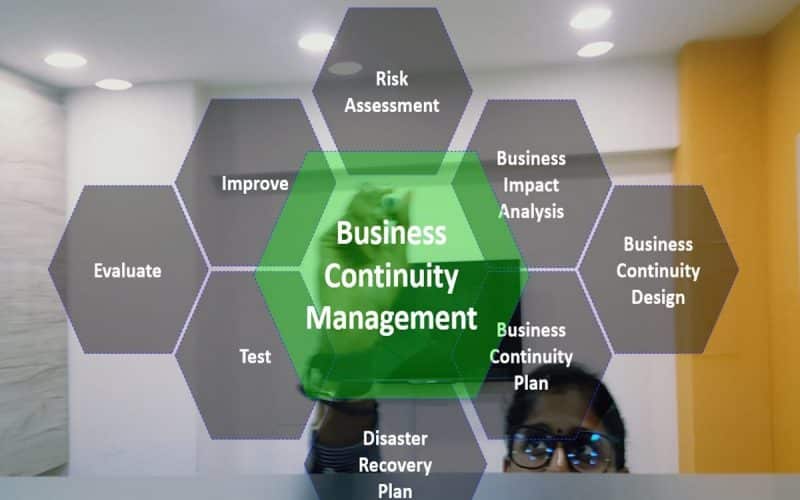Management of business continuity is a key activity. It ensures that your company’s usual business operations continue with minimal disruption after a calamity.
Business continuity management operates on the premise that good response systems lessen the effects of hypothetical catastrophes. Let’s learn more about the business continuity management plan and compare the best software available in this article.
What is Business Continuity Management (BCM)?
Business continuity management is an organization’s planning and readiness for preserving business functions or promptly resuming after a disaster. It also entails identifying potential dangers such as fire, flood, or cyber-attacks.
Business executives devise strategies to recognize and manage potential crises before they occur. The procedures are then tested to confirm that they operate, and the process is reviewed on a regular basis to ensure that it is up to date.
Business Continuity Management Framework
#1. Strategies and Policies
Continuity management entails more than just responding to a natural disaster or a cyber assault. It all starts with the policies and procedures that are created, tested, and implemented when an incident occurs.
Also, the policy establishes the program’s scope, important stakeholders, and management structure. Generally, It must explain the need for business continuity, why governance is crucial throughout this phase.
Knowing who is in charge of creating and also updating a business continuity plan checklist is one component. The other step is to identify the team in charge of implementation. Governance brings order to what may be a tumultuous situation for everyone concerned.
The scope is also important. It defines what the organization’s definition of business continuity is.
Is it a matter of keeping programs running, products and services available, data accessible, or physical locations and people safe? Businesses continuity management must be clear about what a plan covers, whether it is revenue-generating components of the company, external-facing aspects, or some other portion of the overall organization.
These may be clear positions based on work function or particular responsibilities dependent on the type of disruption that may be experienced. Policy, governance, scope, and roles must all be widely stated and also supported in all circumstances.
#2. Business Impact Analysis
The impact assessment is a cataloging process that identifies the data your firm possesses, where it is stored, how it is collected, and also, how it is accessible. It evaluates which of those data are most vital and how much downtime is acceptable if that data or apps are unavailable.
While businesses strive for 100 percent uptime, even with redundant systems and storage capacity, this is not always attainable. This is also the stage at which you must calculate your recovery time objective. This is the maximum amount of time that the business will need to return applications to a functional state in the event of a sudden loss of service.
In addition, businesses should understand the recovery point aim, which is the age of data that is acceptable for customers and your organization to restart operations.
#3. Risk Evaluation
Risk manifests itself in a variety of ways. A Business Impact Analysis as well as a Threat and Risk Assessment should be carried out.
Threats might include negative actors, internal players, competitors, market conditions, domestic and international political issues, and natural occurrences. Creating a risk assessment that identifies potential dangers to the organization is a critical component of your plan.
The risk assessment identifies the wide range of risks that may affect the organization.
The first stage is to identify potential dangers, which can have far-reaching consequences. This includes the following:
- The ramifications of personnel loss
- Consumer or client preference shifts
- Internal agility and the ability to plan for and respond to security problems
- Financial turbulence
Regulated businesses must consider the risk of non-compliance, which can result in significant financial penalties and fines, greater agency attention, and the loss of standing, certification, or credibility.
#4. Testing and Validation
Risks and their consequences must be regularly monitored, measured, and tested. Once mitigation plans are in place, they should be evaluated to verify that they are performing properly and cohesively.
#5. Identification of the Incident
Determining what constitutes an incident is critical in business continuity. In policy texts, events should be clearly specified, as should who or what can cause an incident to occur. These triggering activities should result in the deployment of the business continuity plan as established and the mobilization of the team.
#6. Recovery after a Disaster
What exactly is the distinction between business continuity and catastrophe recovery? The former is the broad plans that direct operations and set policies. When an incident occurs, disaster recovery takes place.
The deployment of teams and measures in response to a disaster is referred to as disaster recovery. It is the end outcome of the work done to identify and mitigate risks. In contrast to broad planning, disaster recovery is concerned with specific incident responses.
Following an incident, one of the most important tasks is to debrief and review the reaction, and then revise plans as needed.
What is a Business Continuity Plan?
A “business continuity plan” (BCP) is a procedure that defines the potential impact of crisis circumstances, develops strategies to respond to them, and assists organizations in fast recovering so that they may resume normal operations. A business continuity management plan is often developed in advance of a disaster and includes important stakeholders from the firm. A BCP’s primary purpose is to protect workers and assets both during and after an emergency.
What is an “Emergency Circumstance” in the Business Continuity Plan?
An emergency scenario is one in which you cannot carry out routine business operations. This might be a natural disaster, such as a fire, flood, or storm, but it could also be a power outage, bomb threat, compliance breach, intruder or active shooter, cyberattack, employee injury, or a disruption in the chain of command. Whatever the situation, organizations should assess potential hazards and develop a business continuity plan (BCP) to ensure that operations continue if a danger becomes a reality.
What is included in a Business Continuity Management Plan?
Business continuity strategies vary from one organization to the next. You should personalize your plan to the specific needs of your firm. Here are some general examples of what a BCP could contain:
- Policy, goal, and scope
- Objectives and goals
- Important roles and responsibilities
- Plans for risk reduction
- A list of actions that must be completed in order for operations to continue.
- Explanation on where to go in the event of an emergency
- Data backup and site backup information
- Protocols for maintenance should be planned.
- Coordination with the local emergency services
- Management personnel’s contact information
Why are Business Continuity Management Important?
Business continuity strategies are an essential component of any company. Threats, disruptions, and disasters can result in revenue loss and increased costs, affecting profitability. Businesses cannot always rely solely on insurance, as insurance may not always cover all costs involved with an incident.
A proactive plan can also help a firm in the following three ways:
- The company will feel more equipped to deal with the unexpected.
- After the disaster, the company will have a plan in place to continue delivering good service.
- The company’s corporate reputation, image, and revenue stream will be better preserved.
Best Software for Business Continuity Management Planning
Business continuity management software assists businesses in identifying and mitigating any operational disruptions. This program is intended to assure the continuous flow of a company’s activities by recognizing risks, calculating their disruptive potential, and executing mitigation processes. Organizations also utilize business continuity management software for regulatory compliance.
Compliance and risk management specialists, as well as departments responsible for quality management and security, are the primary users of business continuity management software. Business continuity management software is often used as part of an organization’s governance, risk, and compliance policies.
Business continuity management software can be offered as a stand-alone solution or as part of a portfolio of governance, risk, and compliance tools. This sort of software interfaces with risk management, disaster recovery, quality management software, and emergency notification software when purchased separately.
A product must meet the following criteria to be considered for inclusion in the Business Continuity Management category:
- Include elements for business resilience, recovery, and contingency planning.
- Provide both conventional continuity plans and ones that can be customized.
- Provide workflows for deploying crisis management plans.
- When incidents occur, notify both internal and external users.
- Calculate the probable impact of various sorts of risks.
- Assess the effectiveness of business continuity activities.
5 Best Business Continuity Management Software
- Oracle ERP Cloud
- iGrafx
- Fusion Frameworks Systems
- LogicManager
- ClearView
Business Continuity Management Software Comparison
#1. Oracle Cloud-based Risk Management
Oracle Risk Management (Oracle GRC Cloud) with incorporated artificial intelligence (AI) approaches can be used to automate advanced analysis for ERP role creation, segregation of tasks (SOX), data privacy (GDPR), and financial fraud prevention.
#2. iGrafx
We feel that the process is central to everything. Our Business Transformation Platform transforms your procedures into a lucrative asset portfolio. iGrafx provides the most comprehensive Business Transformation solutions for process capture and discovery, RPA and workflow automation support, customer experience, governance, risk, compliance, and more, leveraging the power of process knowledge.
#3. Fusion Frameworks System
The Fusion Framework® System, the platform of Fusion Risk Management, serves as the cornerstone for operational resilience. The Fusion Framework makes it simple, visual, and interactive to assess every part of your business, allowing you to find single points of failure, critical risks, and the precise steps you need to take next to mitigate effect. – Map important service and product delivery processes exactly as they are. – Leverage objective risk information to audit, analyze, and improve your organization.
#4. LogicManager
LogicManager thinks that efficient risk management leads to improved performance. Since 2006, its enterprise risk management (ERM) software has enabled enterprises to protect their reputation, plan for the future, and improve company performance. Today, LogicManager’s SaaS platform includes cutting-edge taxonomy technology that contains approximately 100 different point solution packages tailored to your specific business requirements.
#5. ClearView
ClearView is a web-based platform that assists organizations in effectively managing their business continuity management (BCM) activity, which includes risk assessment, business impact analysis (BIA), plan development (for crisis or incident management, business continuity, or disaster recovery), exercise, and testing, and all compliance areas.
#6. SAI360
With a combination of software and learning content, SAI Global Risk, Ethics, and Compliance enables customers to focus on establishing an effective integrated risk management solution. Organizations can build and foster a strong risk and compliance culture, make more confident decisions with a unified view of governance, risk, and compliance, achieve risk-ready oversight of business processes, and strengthen organizational ethics and employee behavior by working together with our expertise.
What is a Crisis Communication Plan?
A crisis communication plan outlines the steps an organization will take to communicate with stakeholders during a crisis, including employees, customers, suppliers, and the media.
What are some common disruptions that can impact businesses?
Common disruptions that can impact businesses include natural disasters, cyber-attacks, power outages, supply chain disruptions, and pandemics.
How can businesses ensure the continuity of their operations during a crisis?
Businesses can ensure the continuity of their operations during a crisis by having a well-prepared BCM plan that includes alternate locations, backup systems, and contingency arrangements for key personnel and suppliers.
How can businesses protect their data during a crisis?
Businesses can protect their data during a crisis by implementing regular backups, using cloud storage solutions, and having a robust disaster recovery plan in place.
How can BCM help businesses maintain customer trust during a crisis?
BCM helps businesses maintain customer trust during a crisis by enabling them to quickly and effectively respond to disruptions and minimize the impact on operations and stakeholders. This can help maintain customer confidence in the business.
What role do employees play in BCM?
Employees play a crucial role in BCM by following established procedures, participating in training and awareness programs, and being prepared to respond in the event of a crisis.
Create a Business Continuity Management Program Today!
Managing business continuity is all about data protection and integrity, both of which may be disastrous if lost.
It should be ingrained in organizational culture. Businesses can accelerate the recovery of key activities by taking a methodical approach to business continuity planning.
Business Continuity Management FAQs
What are the 3 main areas of business continuity management?
Companies must separate business continuity planning into three phases: planning and prevention (resolve phase), disaster response (respond phase) and, return to normal (rebuild phase)
What is the difference between BCP and BCM?
What is BCP/BCM? … BCP should be developed and implemented well in advance for an enterprise to ensure its effectiveness. Business Continuity Management (BCM) is a structure for maintenance/management of the BCP. Most enterprises already may have countermeasures for and to avoid accidents and disaster
What is the purpose of BCM?
The goal of BCM is to provide the organization with the ability to respond to threats, such as natural disasters or breaches in data, and help ensure the business can maintain critical functions and continue its daily business operations to the best of its ability.
What is BCM policy?
The BCM policy provides the framework around which the BCM capability is designed and built. The BCM policy is the key document that sets out the scope and governance of the BCM program.






